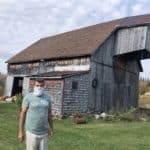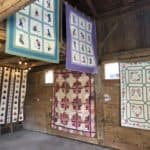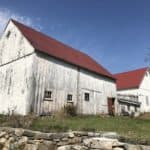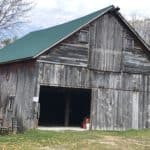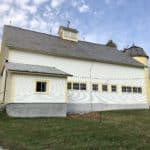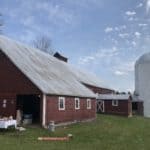MOUNT HOLLY, Vt. – The Mount Holly Barn Preservation Society organized a Covid-conscious fundraising barn tour through six area barns Saturday, Oct. 10. The event brought 40 cars and over 100 people throughout the Mount Holly countryside following a detailed map to each of the participating barns, and raised over $1,000 in the process. The event is not only a fundraiser but also a way to build awareness about Vermont barns. Also critical, according to organizer Donna DeAngelis, was that the event be “fun, educational, family friendly, and safe.”
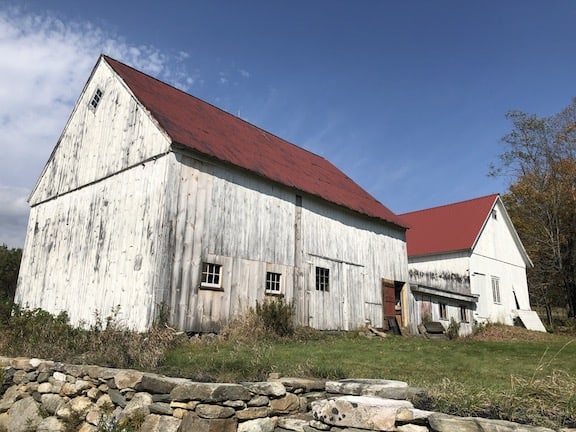
Each of the participating barns had to have been a working barn at one time in their history. For this tour, each barn had partnered with a local vendor, displaying or selling a product at each location whether it be cheese, maple syrup, or homemade cookies.
First on the list was the Holm/DeAngelis barn, a small classic English-style built in 1840. Hung around the barn walls was a collection of stunning quilts all handmade by the Holm family matriarch and nonagenarian Pearl Holm. One of the quilts was raffled off for the event.
Annette Lynch, president of the MHBPS and another organizer of the tour, was the guide for the second barn on the list, the VanDyke Barn, an 1820 early English or threshing barn, and one of the first barns of Mount Holly. Entrances across each other on both sides of the barn were constructed for a wagon to pass through the threshing floor. A higher door was on the entrance side. Lower clearance was all that was needed on the exit side, since the load would have been delivered in the passage. Lynch described the mechanics of threshing and of particular delight was learning that the term “threshold” was born from a plank being fastened in the doorway to keep the grain in while the chaff was blown out the other door. This barn also had a hayloft above the milking parlor, which was on the other side of the threshing area.
The third stop was at the Asphar Barn, which, according to owner Michael Asphar, was the only hooded barn in Vermont. The hood, added after the original construction, is typically found in the Midwest and covers the high window up in the loft where hay is pulled up from the outside with a pulley system.
The expansive Dunwoody Barn was built about 1850 and featured a large yellow silo easily visible on Route 103. Owner Phil Dunwoody has been restoring this family barn since his wife inherited it from her mother in 2007. The farmhouse and barn have been in her family since 1794. He is careful to restore the barn with authentic materials and construction methods and recently restored the cupula, complete with weathervane. Some remaining milking stanchions are still lined up on one side and a large loft area still exists in good shape.
The Stanley Barn, a large 1850 red barn made up of three smaller barns built in succession, features a white silo that has recently been restored on the aptly named White Silo Farm. Different stalls and milking areas make up the quaint ambling structure.
The last stop on the tour was a small Yankee-style horse barn on the Crowley Farm just up from the Crowley Cheese Factory and once part of the same family. Now home to the Davis family, the barn was built around 1830 and features the remnants of three stalls, a gable roof, and a hay loft.
The MHBPS is committed to helping preserve Vermont barns and offers small loans for barn owners who have received funds from the State Barn Preservation Grants offered through the state of Vermont, either helping with providing matching funds needed for the state grant, or a bridge loan before state funding comes through. They also provide some small low-cost loans on their own.
For more information, and to appreciate the beauty and history of Vermont barns, visit their website at www.vtbarnmuseum.com.
